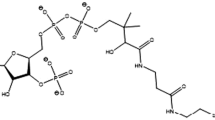Abstract
The appropriate statin to treat co-morbid dyslipidaemia requires careful selection in patient with hepatitis C virus (HCV) infection receiving HCV protease inhibitors (e.g. telaprevir and boceprevir), and those with HIV-1 infection receiving ritonavir- or cobicistat-boosted HIV protease inhibitors. HCV and boosted-HIV protease inhibitors can increase the plasma concentrations of certain statins, thereby increasing the risk of the potential for statin-related myopathy.
Similar content being viewed by others
References
Penzak SR, Chuck SK, Stajich GV. Safety and efficacy of HMG-CoA reductase inhibitors for treatment of hyperlipidemia in patients with HIV infection. Pharmacotherapy. 2000;20(9):1066–7.
Samaras K. Metabolic consequences and therapeutic options in highly active antiretroviral therapy in human immunodeficiency virus-1 infection. J Antimicrob Chemother. 2008;61(2):238–45.
Grunfeld C, Pang M, Doerrler W, et al. Lipids, lipoproteins, triglyceride clearance, and cytokines in human immunodeficiency virus infection and the acquired immunodeficiency syndrome. J Clin Endocrinol Metab. 1992;74(5):1045–52.
Chauvin B, Drouot S, Barrail-Tran A, et al. Drug–drug interactions between HMG-CoA reductase inhibitors (statins) and antiviral protease inhibitors. Clin Pharmacokinet. 2013;52(10):815–31.
Ucar M, Mjorndal T, Dahlqvist R. HMG-CoA reductase inhibitors and myotoxicity. Drug Saf. 2000;22(6):441–57.
Williams D, Feely J. Pharmacokinetic-pharmacodynamic drug interactions with HMG-CoA reductase inhibitors. Clin Pharmacokinet. 2002;41(5):343–70.
Ferenci P, Reddy KR. Impact of HCV protease-inhibitor-based triple therapy for chronic HCV genotype 1 infection. Antivir Ther. 2011;16(8):1187–201.
Chopra A, Klein PL, Drinnan T, et al. How to optimize HCV therapy in genotype 1 patients: management of side-effects. Liver Int. 2013;33(Suppl 1):30–4.
Thompson MA, Aberg JA, Hoy JF, et al. Antiretroviral treatment of adult HIV infection: 2012 recommendations of the International Antiviral Society-USA panel. JAMA. 2012;308(4):387–402.
Aberg JA, Tebas P, Overton ET, et al. Metabolic effects of darunavir/ritonavir versus atazanavir/ritonavir in treatment-naive, HIV type 1-infected subjects over 48 weeks. AIDS Res Hum Retroviruses. 2012;28(10):1184–95.
Friis-Moller N, Reiss P, Sabin CA, et al. Class of antiretroviral drugs and the risk of myocardial infarction. N Engl J Med. 2007;356(17):1723–35.
Bellosta S, Corsini A. Statin drug interactions and related adverse reactions. Expert Opin Drug Saf. 2012;11(6):933–46.
Niemi M, Pasanen MK, Neuvonen PJ. Organic anion transporting polypeptide 1B1: a genetically polymorphic transporter of major importance for hepatic drug uptake. Pharmacol Rev. 2011;63(1):157–81.
Ieiri I, Higuchi S, Sugiyama Y. Genetic polymorphisms of uptake (OATP1B1, 1B3) and efflux (MRP2, BCRP) transporters: implications for inter-individual differences in the pharmacokinetics and pharmacodynamics of statins and other clinically relevant drugs. Expert Opin Drug Metab Toxicol. 2009;5(7):703–29.
Koenen A, Kroemer HK, Grube M, et al. Current understanding of hepatic and intestinal OATP-mediated drug–drug interactions. Expert Rev Clin Pharmacol. 2011;4(6):729–42.
Tamraz B, Fukushima H, Wolfe AR, et al. OATP1B1-related drug–drug and drug–gene interactions as potential risk factors for cerivastatin-induced rhabdomyolysis. Pharmacogenet Genomics. 2013;23(7):355–64.
Williams GC, Sinko PJ. Oral absorption of the HIV protease inhibitors: a current update. Adv Drug Deliv Rev. 1999;39(1–3):211–38.
Martinez-Cajas JL, Wainberg MA. Protease inhibitor resistance in HIV-infected patients: molecular and clinical perspectives. Antiviral Res. 2007;76(3):203–21.
Mouly SJ, Matheny C, Paine MF, et al. Variation in oral clearance of saquinavir is predicted by CYP3A5*1 genotype but not by enterocyte content of cytochrome P450 3A5. Clin Pharmacol Ther. 2005;78(6):605–18.
Wilby KJ, Greanya ED, Ford JA, et al. A review of drug interactions with boceprevir and telaprevir: implications for HIV and transplant patients. Ann Hepatol. 2012;11(2):179–85.
Mathias AA, German P, Murray BP, et al. Pharmacokinetics and pharmacodynamics of GS-9350: a novel pharmacokinetic enhancer without anti-HIV activity. Clin Pharmacol Ther. 2009;87(3):322–9.
Deeks ED. Cobicistat: a review of its use as a pharmacokinetic enhancer of atazanavir and darunavir in patients with HIV-1 infection. Drugs. 2014;74(2):195–205.
Disclosure
This article was adapted from Clinical Pharmacokinetics 2013;52(10):815–31 [4]. The preparation of this article was not supported by any external funding.
Author information
Authors and Affiliations
Consortia
Rights and permissions
About this article
Cite this article
Adis Medical Writers. To avoid muscle-related adverse events, choose statins carefully in patients receiving antiviral protease inhibitors. Drugs Ther Perspect 30, 264–267 (2014). https://doi.org/10.1007/s40267-014-0122-8
Published:
Issue Date:
DOI: https://doi.org/10.1007/s40267-014-0122-8



